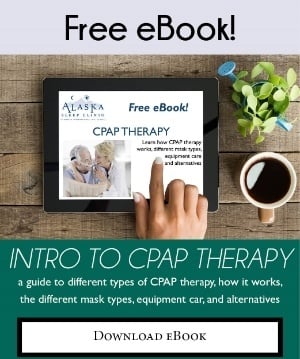How Can I Get Used To This CPAP Mask?
By far the most frequent concern we hear at the Alaska Sleep Clinic is, “How am I ever going to get used to wearing a mask on my face all night long?” While it is not natural to have something covering your mouth and/or nose, with proper mask selection and acclimation, the vast majority of people with Obstructive Sleep Apnea (OSA) can get over their fear and anxiety very quickly and start to enjoy the restful, restorative sleep that Continuous Positive Airway Pressure (CPAP) provides.
CPAP Mask Selection
The patients’ first exposure to CPAP and the various masks usually determines their long term success with therapy. If that first session doesn’t go well, you’re fighting an uphill battle, whether you are the sleep technician trying to get a good study or the Durable Medical Equipment (DME) technician setting the patient up with a machine. The patients’ battle starts with accepting the fact that they stop breathing in their sleep and that the best treatment for that is to wear a mask that will blow pressurized air into their airway, all night long, every night, probably for the rest of their life.
The three most common classes of masks are: nasal pillows that go just into the nostrils, nasal masks that cover the nose and full face masks that cover the nose and mouth. A fourth, less common variety is the hybrid mask that joins nasal pillows with a cushion over the mouth. Within each class, there are usually multiple styles. The thing to remember is, they all do the same thing: deliver air pressure. One is no better than another, it depends on which one is the most comfortable to the wearer.
The technician can give the patient the best path to success by educating them about OSA while providing a thorough, informative mask fitting with several varieties of masks and allowing the patient to control the mask choice. At the Alaska Sleep Clinic, all of our sleep techs are Registered Polysomnograhic Technicians (RPSGT) and our DME techs are also either RPSGTs or have been trained by RPSGTs. Additionally, many of us are also respiratory therapists. All that combines to give the patient a good knowledge base about CPAP as well as tips and techniques to select the right mask and how to acclimate to its’ use.
Mask Desensitization
It is important in a sleep study with CPAP titration or a Split Night study where CPAP is added part way through the night that the patient tries several masks with a low pressure and is allowed to choose their favorite before the study ever starts. It’s never very successful to wake a patient at two in the morning and slap a mask on and expect them to go back to sleep if they’ve had no exposure. If you are having a sleep study that may result in CPAP and the technician doesn’t have you try any masks, you should insist on it.
Many patients with claustrophobia will do best if they can just hold the mask to their face to get used to the air pressure before the headgear is put on. The technician must always be patient and let the client control the pace. With some practice and encouragement, most people get acclimated after just a few minutes.
People sometimes have some further difficulty getting used to the mask once they get home. We often suggest using CPAP in the living room while watching TV, reading, knitting, etc. It gives your brain something else to think about instead of focusing on your breathing and having a mask on.
At the Alaska Sleep Clinic we realize that it’s often the mask that will make or break a person’s success with CPAP therapy, so we have a very liberal exchange policy to help you find the best. We carry a wide, multi-brand variety of masks to choose from, so if you don’t like the one you purchased, bring it back within 30 days and we’ll exchange it with another mask of your choosing. Our goal is to not only find the mask that you can live with, but one that will give you a better life.


